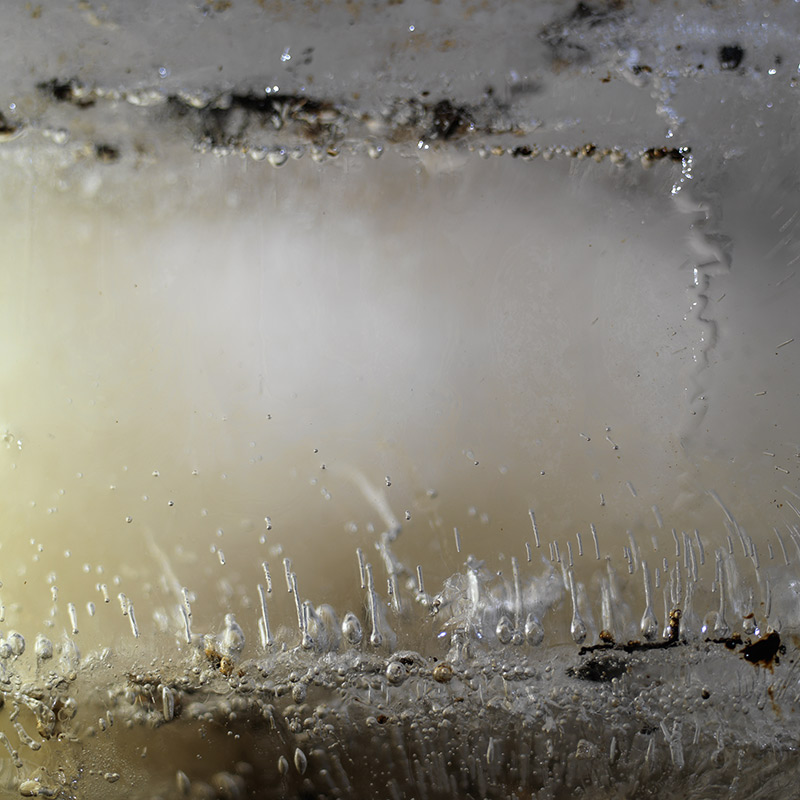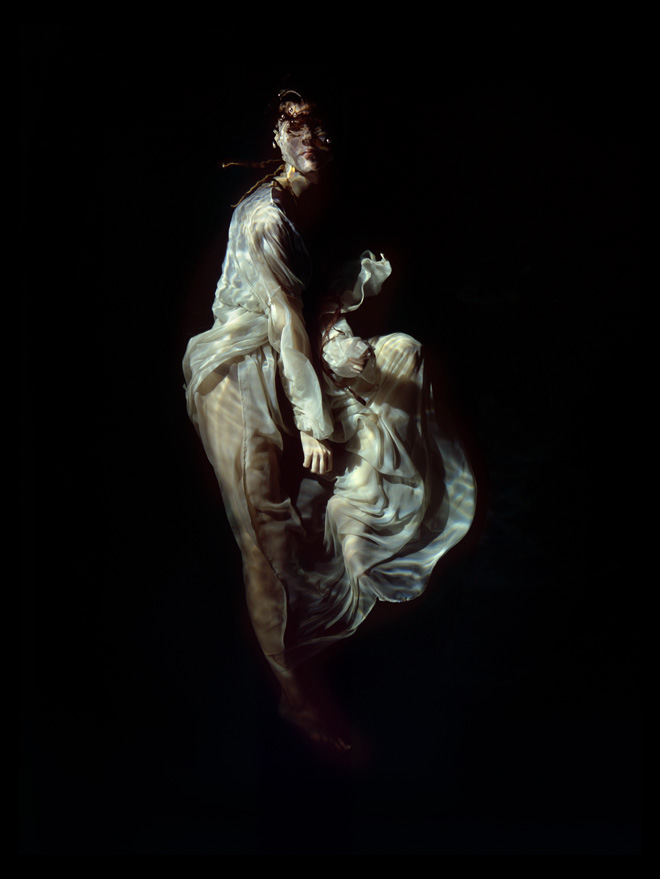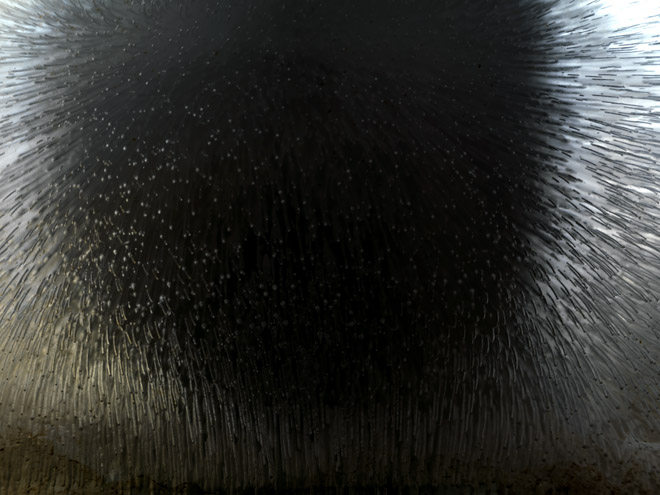INTERVIEW: Alexander James talks about his Oil and Water project, created in Siberia
Above: Ptolemy, Oil and Water project / Courtesy of Alexander James and Distil Ennui Studio
Alexander James is an artist working on a cross-road of media, combining painting, photography and sculpture. Using water as his main theme and environment for his objects for thirty years, Alexander has recently completed a new project – Oil and Water, executed in Siberia. Creating physical forms out of solidified crude oil and then entombing them in an ossuary of frozen river water, the artist explores the relationship between these two resources, central to the survival and industrial development of the human species. We met with Alexander to talk about his projects, time in Russia and the role of an artist today.

Princess Tarakanova, 1864, by Konstantin Flavitsky / Courtesy of Tretyakov Gallery
Anna Prosvetova: Alexander, you have been working in many locations around the world but two of your recent projects were completed in Moscow and Siberia. Why did you become so interested in Russia? Alexander James: I have had one hundred and six solo shows prior to Distil Ennui exhibition in Moscow, at Triumph gallery. I have never had a job, I have been an artist all my life and I take it very seriously; it is my vocation. I think for any serious artist throughout the ages there is always a dialog of great importance with certain countries and certain periods. If you Google a Consdiv painting now or stop a thousand people and ask anyone the name of that painting, you would not find one person who can answer it. When I first went to Russia I went to a dinner at the British Embassy in Moscow. I also visited the Tretyakov gallery and saw one painting that I just felt in love with: Princess Tarakanova by Konstantin Flavitsky. I have got a reproduction of this painting with me when I went to that dinner, and I could not take my eyes of it. And the waiting staff at the dinner all knew the story behind the painting; who painted it, where it was hanging and the history of the period in general. Such situations are like a drug to a serious artist, and I was hooked. Russia does not really care to be fashionable in the arts world, but they do care about their lives dedicated to the arts. They understand, that if a man gives his body and soul to the artistic practice, this is something they want to learn about. So, I came back, done some research and contacted galleries in Moscow about an exhibition.
AP: How did the project Oil and Water come about?
AJ: This project is different from my previous work. There was no intention to show it; it was an intention to do something that has never been done before. I gave my work to a curator in St Petersburg and that I would be back to do a project in Siberia that no one has even dreamed of. He asked me: “When?” I have answered: “By the end of the year.” He called me crazy, because by this time I have already driven a ten-ton truck with my studio from London to Moscow. “Everyone thinks that you are insane already, but they love you for it.” I have three things to offer in live: my work, my hand and my word, and I treat all of them with equal importance.

Oil and Water project / Courtesy of Alexander James and Distil Ennui Studio
I do not want to be political, but at the moment it seems that we are having so many battles over the access to oil. I have known for thirty years now that human water management policies, locally and globally, are shocking. Very soon half of Australia’s land over private water will be owned by Coca-Cola company. Ohio has no water; in Barcelona half of its water is produced by a nuclear desalination process. After thirty years of my work, creating sculptural works under water, I thought that Siberia is a perfect place for my next project. Siberia has biblical reserves, with the scale of the territory and everything there. I have been to Krasnoyarsk last year, I have got a lot of friends in Siberia, but I have extended it a little bit further this time. I had three studious: one was in Krasnoyarsk, in a boathouse; one was in the Urals, up on the planes, and the other was in Perm, the oil place. The reason I did this because I really needed the right conditions, and I travelled between them depending on which one was the coldest at the moment.
I was very lucky, because I managed to collaborate with one of the oil companies, without any financial remuneration or cross-pollination. I just let them know that I was coming, and they understood that I am a serious artist and were remarkably helpful. I am very grateful for that.
AP: What was your process of working? Did you have a team to assist you in Siberia?
AJ: I was working alone on my Oil and Water project, because the nature and the scale of it differed from my previous work. For example, I had a team of assistants in Moscow when I was working on my Distil Ennui project, because figurative work is incredibly difficult. You are working in two hundred-ton tanks of water and the scale is just enormous. I also needed a stylist and make up artists. I was lucky, because Russia has a certain amount of creative talent, and all my team was local.
AP: In your artworks you usually use liquid water. Was it different this time to work with the frozen water?

Jupiter, from Distil Ennui project / Courtesy of Alexander James and Distil Ennui Studio
AJ: My process is a mixture between painting, sculpture and photography. When I create my water works, I use a paintbrush on the surface of the water and I also paint with light. This time it was a very different process. I did not really know much about how the infusion would go; it was a new area for me. I found it fascinating; I was like a child. It was like capturing fireworks in ice when the explosion of the gas in the oil happens; it is like a gun going off. I had a microphone, embedded into the ice, and you can hear that it is a violent moment, though you would not think so. I also have videos for each work, with the oil gently melting: it is the most beautiful thing.
I found it interesting to works with ice. One reacts very differently to this kind of works. You walk up to such ice sculptures; they are very large and heavy. The frost clouds and you do not really see what is inside for the first moment; it looks like a dirty piece of glass. But all of a sudden you realize what this is, what is going on behind the ice. I think the fact that the object exists only because of your personal endeavour, your personal effort in itself is quite a dictum to my artistic process: I like showing the outside of the gallery construct. I think I will continue working with both liquid and frozen water in future.
AP: In all your projects you cultivate your objects before placing them in the final work. How did you come about this idea, this process? Why is it important for you to grow a flower?
AJ: There are no Renaissance artists anymore. Everybody use the same materials, going to the store and buying the same colour blue that other artists use. Who mixes their own paint? Who makes their own canvas? Who does anything in the studio that is truly of a craftsmanship level, as, for example, the eggs of Faberge? I want people to come to my studio and see a real craftsmanship.
People usually want two things from me: my time or my work, and I have got very little of both. I have already spent thirty years, bouncing between gallery and museum circles, and it has not been a joyous experience. The only thing I ask is that if they are going to spend time and be resolute about what it is I am doing, at least I gain understanding from it. I do not really want Tate Britain or Tate Modern to come to my studio to see my work, because if you accept this form of an institutional art, you would become an institutional artist. But I do not want to paint the same thing for the next ten years. I want something that physically and mentally challenges me. The more well-known you are the more scared you are of breaking the boundaries. You need to walk in the face of failure, you really do.
For example, for my Oil and Water project I had to experiment with the process, because there is no way of finding out the results; it has never been done before. I just thought: “Why not!” I am not going to change my practice just to suit someone; everything is possible.
AP: What is your background? Were you trained as an artist?
AJ: I am completely outside of the academia. I left home when I was fifteen, and by the time I was sixteen I have been living in another country. I have relocated my studio to seventeen countries. What can anyone teach me that I cannot teach myself? For instance, I have a Krasnoyarsk October piano in the studio: I still do not know how to play it, but I will learn it. Everything is possible; what you need is time and willpower.

Dark Matter, Oil and Water project / Courtesy of Alexander James and Distil Ennui Studio
AP: I was intrigued by the description of Oil and Water project where you mentioned that you have been returning the frozen blocks of water and oil to the original locations, where the oil came out of the ground. Why did you decide to do it?
AJ: Yes, it was in the forest. I was working outside all day; ten hours a day at -50°C. It was absurd, but it was the only way to be actually able to do it. For example, this particular piece, Dark Matter. It is a two-foot perfect sphere of oil. It was cast outside and then it was set in an ossuary of a frozen river water, with the oil formation in the centre. The saddest thing was that I could not take these things back home with me, because the sculptures themselves were so beautiful; they felt like children to me. I am thinking about them and how they are melting down there, in the forest. It would be interesting to fly back and see them.
AP: Have you been influenced by Russian culture during your time in the country?
AJ: I have seen an exhibition at Perm, in the museum of contemporary art. It was a great show! Of course, I have been influenced in general by the environment, people and the culture. It has already influenced my studio in London; there are new flavours of work coming through. Bear in mind, that my aesthetic is black. For thirty years my works have been sold at auction houses around the world. And now I think it is changing somehow. They always say: “Never confuse your audience”, and I think I am confusing my audience now with my new projects.
As for the art, I have also been a great fan of Kandinsky, but to be impressed by a single piece by an artist, I think, is a rather naive notion. Every painter has at least three pieces as their signature, and I just want to see these three. Fortunately, my signature runs across three hundred pieces, because of the water theme.
AP: You use social media quite a lot to showcase your work. Do you use it to get a creative inspiration?
AJ: No, I do not use social media to get an inspiration. I did not even go to the shows for the first ten years of my career. We are all sponges, and the younger we are the more absorbent we are. I see everything now, I go to every show, but I am not a sponge anymore. I know what is there and what is missing. I collect myself quite heavily, but I have different reasons to do that.
I think social media is a great way to spread the word out. I have been doing my work for thirty years and I am getting recognised now, but I need to accelerate that and make myself noticed. It is important. Rauschenberg painted billboards in Hollywood. One thing he said about it was: “I may be a great artist, it is your opinion. To make art is something, but to get the art seen is more of something.” This is really of value, because I believe in the aesthetic of traditionalism. I believe that actually something has to be earnestly beautiful. When you know that the artist has suffered when he created the work. Many contemporary works show no craftsmanship; they show nothing other than a need for publicity.
AP: What are your future projects? And where are you going to move your studio next?
AJ: I am deeply satisfied with the outcome of Oil and Water project. We are thinking about showing the project in Russia, but it is not decided yet. Now I want to sit with the works and enjoy them. I am planning to go back to Russia, I still have a space there I can work from. I am very excited about things, we have a strong collectors’ base now with pieces going off to Christie’s, Bonhams and Sotheby’s this year.
I am a great believer that if you say something, you must follow it through. There are two projects on the div right now, and if I disclose both of them, I will have to do both of them, so I will keep it to myself for now.
AP: Alexander, thank you!
Please visit Distil Ennui Studio for more information about the project.
This interview was originally published on Russian Art and Culture.